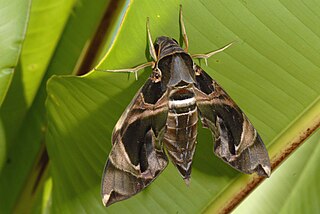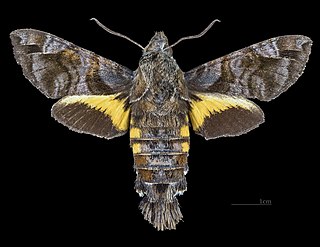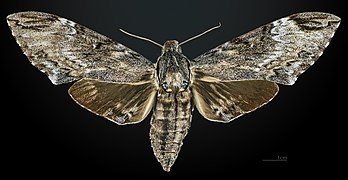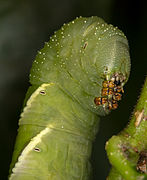
Acherontia styx, the lesser death's head hawkmoth or bee robber, is a sphingid moth found in Asia, one of the three species of death's-head hawkmoth. It is very fond of honey, and bee keepers have reported finding dead moths in their hives as a result of bee stings. They can mimic the scent of bees so that they can enter a hive unharmed to get honey. Their tongue, which is stout and very strong, enables them to pierce the wax cells of the beehive and suck the honey out. They are also known to be a pest of yuzu in South Korea, using their tongue to pierce and damage the fruit.

Daphnis nerii, the oleander hawk-moth or army green moth, is a moth of the family Sphingidae. It was described by Carl Linnaeus in his 1758 10th edition of Systema Naturae.

Theretra oldenlandiae, the impatiens hawkmoth, taro hornworm or white-banded hunter hawkmoth, is a member of the family Sphingidae.

Marumba dyras, the dull swirled hawkmoth, is a species of hawk moth described by Francis Walker in 1856. It is found in South-east and South Asia.

Daphnis hypothous, the jade hawkmoth, is a moth of the family Sphingidae described by Pieter Cramer in 1780. It is known from Sri Lanka, southern and northern India, Nepal, Myanmar, southern China, Taiwan, Thailand, Malaysia, and Indonesia. It is a rare vagrant to the Western Palaearctic realm. During the last hundred years a number have been discovered within the Middle East and one was even found in Scotland late in the 20th century but this was probably imported as a pupa with cargo.

Theretra clotho, the common hunter hawkmoth, is a moth of the family Sphingidae. It is found from Sri Lanka, India, Nepal and Myanmar, east through China to Taiwan, South Korea and Japan, and then south-east through South East Asia as far as the Lesser Sunda Islands and Timor in Indonesia. They can disperse long distances and may be found up to northern China. The habitat consists of open forests, forest edges, orchards, plantations, wooded scrubs, suburban gardens and city parks.

Theretra latreillii, the pale brown hawk moth, is a moth of the family Sphingidae described by William Sharp Macleay in 1826. It is found in most of Asia, including Borneo, China, Hong Kong, the Philippines, Taiwan and also throughout the tropical and temperate regions of Australia.

Theretra nessus, the yam hawk moth, is a moth of the family Sphingidae. It was described by Dru Drury in 1773.

Hippotion velox, the dark striated hawkmoth, is a species of sphingid moth or the family Sphingidae. The species was described by Johan Christian Fabricius in 1793.

Macroglossum gyrans is a moth of the family Sphingidae. It was described by Francis Walker in 1856 and is known from South-east Asia and Madagascar.

Macroglossum insipida, the hermit hummingbird hawkmoth, is a moth of the family Sphingidae. It was described by Arthur Gardiner Butler in 1875.

Eudocima salaminia, the green fruit-piercing moth, is a moth of the family Erebidae. The species was first described by Pieter Cramer in 1777. It is found from India, and across south-east Asia to the Pacific Islands. In Australia it occurs in the Northern Territory, Queensland and New South Wales. The adult is a fruit piercer.

Pergesa is a monotypic moth genus in the family Sphingidae first described by Francis Walker in 1856. Its only species, Pergesa acteus, the green pergesa hawkmoth, was described by Pieter Cramer in 1779.

Acosmeryx shervillii, the dull forest hawkmoth, is a moth of the family Sphingidae. The species was first described by Jean Baptiste Boisduval in 1875. It is found from the Indian subregion, Sri Lanka, to Sundaland, the Philippines and Sulawesi. Acosmeryx pseudonaga is sometimes treated as a valid species.

Amplypterus panopus, the mango hawkmoth, is a moth of the family Sphingidae. The species was first described by Pieter Cramer in 1779. It is found in Sri Lanka, southern and northern India, Nepal, Myanmar, southern China, Thailand, Vietnam, Laos, Indonesia and the Philippines.

Rhagastis albomarginatus is a moth of the family Sphingidae.

Psilogramma casuarinae, the Australasian privet hawk moth, is a moth of the family Sphingidae. The species was first described by Francis Walker in 1856. It is known from New South Wales, the Northern Territory and Queensland, all in Australia.

Dolbina inexacta, the common grizzled hawkmoth, is a species of moth of the family Sphingidae.

Ambulyx substrigilis, the dark-based gliding hawkmoth, is a species of moth of the family Sphingidae. It was described by John O. Westwood in 1847.

Ischyja manlia is a species of moth of the family Noctuidae first described by Pieter Cramer in 1776. It is found in the Indian subregion, Sri Lanka, Myanmar, Thailand, China, Okinawa, Sundaland, Sulawesi, Korea, the southern Moluccas, Australia (Queensland) and Palau. Adults pierce the skin of fruit to suck the juice.

























